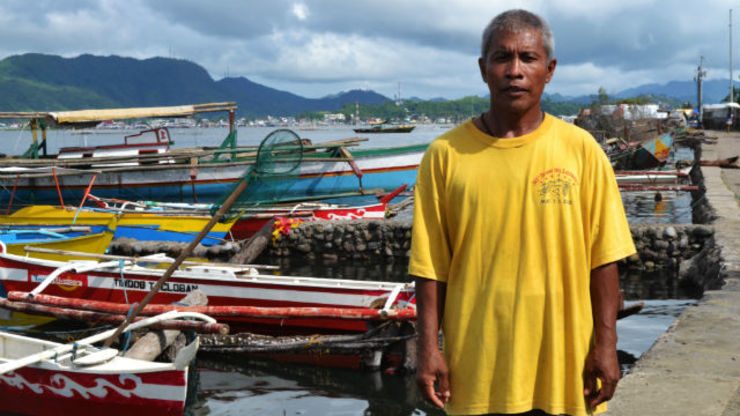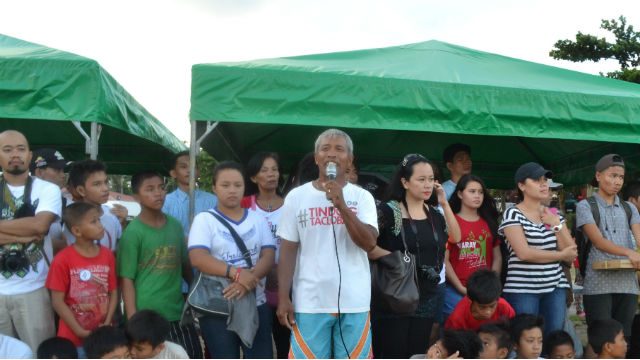SUMMARY
This is AI generated summarization, which may have errors. For context, always refer to the full article.

TACLOBAN CITY, Philippines – When the manaratbat – a person, usually an old man or woman, who officiates the prayer for the dead – does not arrive, Losanto ‘Ka Jun’ Castillo, a spry fisherman in his 50s, tells me he will improvise.
We are on Cancabato Bay, Tacloban, about to begin a ceremony to remember the dead of Yolanda – more than 6,000 of them, according to government statistics. The strongest typhoon to make landfall in recorded history, Yolanda drove a storm surge at least as high as 10 feet across parts of the Visayas, pummelling property and lives in its path on November 8, 2013.
Ka Jun clears his throat and begins to pray under a small tent on the shore of Cancabato where bodies had washed up in the aftermath of Yolanda: “Panginoon, huwag mo kaming pabayaan.” (Lord, do not forsake us.) In place of the memorized lines of the manaratbat, Ka Jun is talking to God.
Ka Jun has 7 children and is the leader of the Tacloban Urban Fisherfolk Association, a group of 300 fisherfolks that have banded together to advance their causes.
He is a widower; his wife had survived Yolanda, but died from an undiagnosed illness weeks after the typhoon struck.
“When they couldn’t do anything for my wife, I lost it. I wailed at the doctors and they didn’t stop me. They probably knew I had gone through a lot.”
– Ka Jun Castillo, fisherman, widower, father of 7
Reeling from the devastation of his home and fishing boat, and the loss of the few belongings his family had, Jun made a scene at the hospital when his wife died: “When they couldn’t do anything for my wife, I lost it. I wailed at the doctors and they didn’t stop me. They probably knew I had gone through a lot.”
Just as Ka Jun starts to pray, surfers of the Leyte Gulf Surfers take turns jumping off the jetty into the water. Paddling out to sea on their long boards, they slowly form a circle around a big wreath of white chrysanthemums released on the water earlier.
On small boats, fishermen from Ka Jun’s association then circle around the surfers. The current keeps the surfers and fishers from perfecting their circles.
The fishermen light candles and the surfers throw flowers into the water around the wreath. The paddle-out, which is a practice of surfers in Polynesia, is the idea of Dennis Delgado of artists’ group Guli-at Kankabato to commemorate today those who perished during Yolanda.
All this time, Ka Jun has kept his conversation with God, praying for the fisherfolk of Leyte to see better days.
Fishing after Yolanda
Even before Ka Jun begins his prayer, a sizeable crowd has formed along the shore of the bay. By the time the surfers and the fishermen congregate on the water, the crowd’s number has ballooned into a thousand. Many have come back to the edge of the water, to the memory of the storm surge which changed their lives forever one year ago.
One year ago, Ka Jun’s fish catch was 5 kilos; now, it is half a kilo. Al Bernarte of NGOs for Fisheries Reform (NFR), a network of nongovernmental organizations providing assistance to fisherfolk groups such as Ka Jun’s group, says this is because coral reefs, which are the breeding grounds of fish, have been destroyed, the waters of Eastern Visayas had been overfished even before Yolanda, and there are volumes of debris underwater waiting to be cleared.

Ka Jun may also need to move out of his home in Brgy. 88, in Tacloban, because of the government’s policy on no-build zones, which bars rebuilding houses or settlements 40 meters from the shore.
This policy has people’s interests at heart, to be sure, but it also contradicts the idea of fisherfolk settlement: fisherfolk should live close to fishing grounds, the source of their livelihoods, as enshrined in section 108 of the Philippine Fisheries Code. Ka Jun prefers a middle-ground solution: a safe place fisherfolk can evacuate to in times of typhoons like Yolanda.
In a conversation two days before, Ka Jun told me he does not like the idea of relocation.
“The 40-meter rule does not make sense. A tsunami can reach up to 10 kilometers of Tacloban from the shore,” he said. He told me he needs to be close to the sea so he can keep on making a living.
Which is not to say Ka Jun and fisherfolk like him had it easy before Yolanda. Fisherfolk are the poorest of the Fililipino poor, with a poverty incidence rate of 39.2%. They’ve lived along the water, always at risk of danger.
Yolanda merely brought their underlying vulnerability to the surface. This is why ensuring that they earn their keep will go a long way towards helping them recover from Yolanda and to thrive amidst the threat of disasters.
“The government needs to have a solid livelihoods plan for the fisherfolk in the Yolanda corridor. We need to rehabilitate heavily exploited fishing grounds and manage coastal resources, especially those in the Yolanda-hit areas. Assessments of coastal and marine resources need to be conducted right away,” Bernarte said. “Alternative livelihoods being offered by the government must be related to fishing or, at least, easy to learn. Fisherfolk have been fishing all their lives and we cannot expect them to learn a new trade in a matter of weeks or months,”
The trauma of the year past, and the days ahead – of low fish catch, the idea of relocation, the loneliness of widowhood – seem to break and bring tears to Ka Jun’s voice as he talks to God on the first anniversary of a catastrophe.
Ka Jun, taking on the role of the manaratbat or, in a sense, a healer, faces the vast gray Cancabato Bay, and searches and finds words to a prayer for the devastation – inside and out – to cease haunting him a year after Yolanda, when much more should have already changed. – Rappler.com
Maya Quirino is the economic justice campaign manager of the Philippines office of Oxfam.
Add a comment
How does this make you feel?
There are no comments yet. Add your comment to start the conversation.